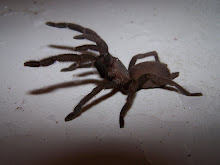New Sciency Stuff Coming Soon...
I'm actually working on a few things right now. Both about parasitoids...expect them soon.
But let's review exactly what a parasitoid is. A parasitoid has characteristics of a predator and a parasite. They live within their host, taking nutrients from them kind of like a parasite. However, very much unlike most parasites, they eventually kill their hosts as well.
Let's take a tapeworm, for an example we can use to contrast between a parasite and a parasitoid. The dumbest thing a tapeworm could do is to kill it's host. Why would it? It's got it made-nice safe environment in the gut of some animal that keeps it safe. All the food it could ever want delivered to it...it doesn't have to chew, that's done by the host. All it's had to do to survive is evolve into an inside-out intestine and become hermaphroditic.
Remember this scene from the movie Alien?
You know, the creature that emerges from Kane at about 2:00 in?
That's what a parasitoid is. A bit of a greusome example but to me, parasitoids are only beautiful because they're so damn ugly in the way they live their lives. All parasitoids are larvae. They're either hymenoptera or diptera...wasps and flies, respectively. There's a few butterflies and beetles which are parasitoids as well. Even though parasitoids are extremely different from one another, they all have an adult stage that's free living. This is why they can afford to kill their hosts.
True parasitic relationships in the insect world are rare. The only example that immediately comes to mind is Strepistera...twisted-wing parasites which live inside wasps. They actually do some really cool things, like extend the lifespan of their host.
They come in two flavors...idiobionts, which eat their host as-is and don't allow it to grow or moult any further and koinobionts which benefit from the extended development of thier hosts, usually not killing their hosts until they pupate. Parasitoids can either live inside or outside their hosts. If they live on the outside of their hosts, they're called 'ectophagous parasitoids'. Ecto = outside and phagous = eating. Parasitoids that live inside their hosts are called endophagous parasitoids, which means 'inside-eating'.
Parasitoids that parasitoids parasitoids are hyperparasitoids. Parasitoids that parasitize parasitoids that parasitize parasitoids are 'tertiary parasitoids' so on and so forth. It's confusing as hell, but that's what I'm here for.
So...why do I love parasitoids so much?
Well, they violate everything we hold sacred. They violate the body by burrowing inside it and consuming it from the inside-out. They violate the mind by taking control of their hosts. They violate this absurd notion that life is sacred by using their host until it can't give any more and then killing it. Any notion that we might lose our spot at the top of the food chain is absolutely horrifying to us...and Hollywood plays on those fears in many big and low-budget movies. It's definitely not a bad thing...I'll be comparing parasites to various Hollywood monsters in many of my posts.
Parasitoids have some really cool adaptations to compete amongst themselves and to subdue their hosts. Some are neurosurgeons, and I've mentioned that some take over their hosts. Some fight wars inside their hosts, and some produce their own viruses. Some parasitize other parasitoids and some parasitoids even parasitize themselves.
So. Yeah. Parasitoids are really cool. They really are miniature real-life horror movies. Because, you see, we have creatures almost exactly like the creature from Alien here on Earth...it's not a unique creation of Hollywood.
Critters which are known as bee-flies (Family Bombyliidae) actually resemble the creature from Alien even more than the hymenoptera (parasitic wasps) it's generally associated with. Remember how Kane first got acquainted with the critter from alien?
Well Bombyliidae actually have a similar manner of host location, where the larva finds the host after the adult lays the egg. The first instar larvae of these guys kind of have legs and actually look for their hosts. When the larva finds a suitable host, the larva burrows into it, moults into a maggot that looks a bit more familiar, feeds and then exits it's host as parasitoids do. Then it pupates and emerges as something which looks a lot like a bumble-bee.
So Alien isn't exactly a new creation...we've had something like it for a few million years or so. It was just a little bit smaller than we expected.
Labels: Blag, Entomology, Movies, Parasites


0 Comments:
Post a Comment
Subscribe to Post Comments [Atom]
<< Home